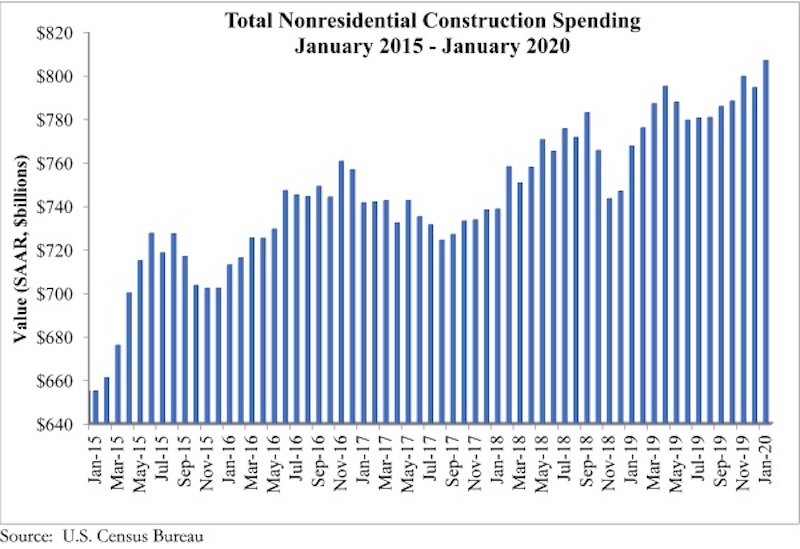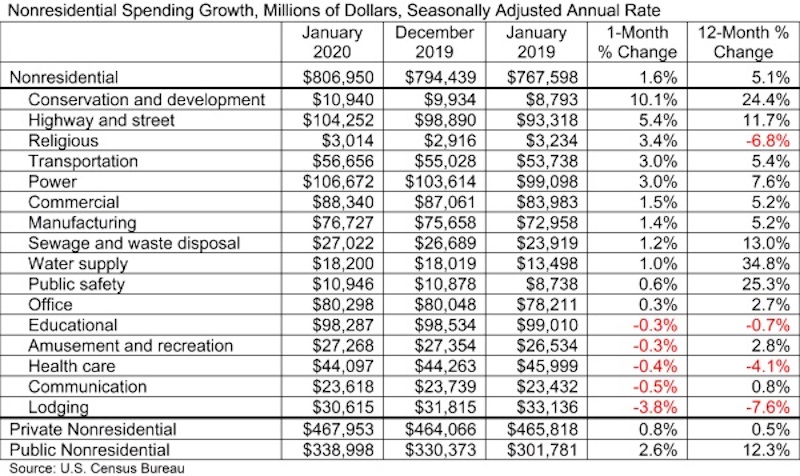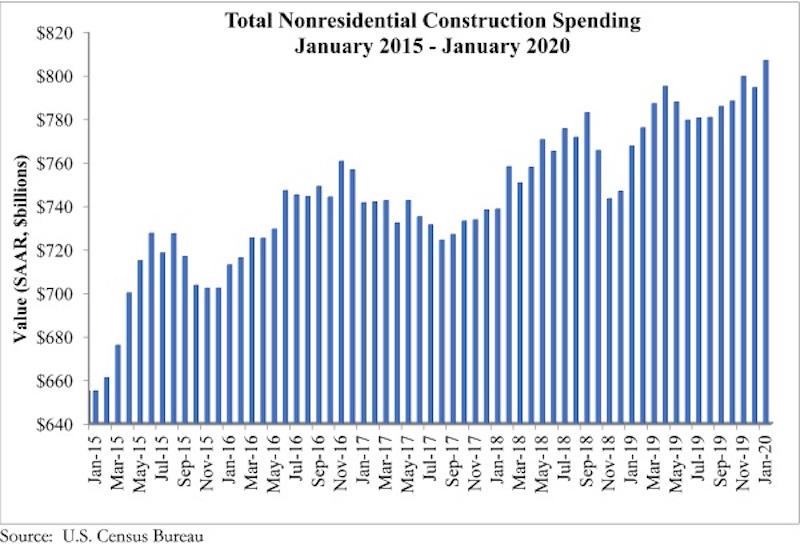National nonresidential construction spending increased by 1.6% in January and is up 5.1% on a year-ago basis, according to an Associated Builders and Contractors analysis of data published today by the U.S. Census Bureau. On a seasonally adjusted annualized basis, spending totaled a record $806.9 billion in January.
Private nonresidential spending rose 0.8% on a monthly basis and is up 0.5% compared to the same time last year. Public nonresidential construction spending also increased, rising 2.6% for the month and 12.3% on a year over year basis.
“Despite all the focus on the dislocating impacts of the coronavirus, construction—a key element of the U.S. economy—continues to perform,” said ABC Chief Economist Anirban Basu. “For the first time in history, the volume of nonresidential construction spending exceeded $800 billion on an annualized basis and now stands at an all-time high. Both public and private nonresidential construction spending expanded to start 2020, a reflection of the broader economic momentum evident over the last several years. Backlog remains healthy, according to the ABC Construction Backlog Indicator, and with the nation continuing to add jobs, there is more demand for public and private construction and additional funding resources. This is especially apparent in several infrastructure categories, in which spending growth continues to be robust due to healthier state and local government finances.
“That said, there is no question that the coronavirus has significantly compromised both global and national economic momentum over the past two to three weeks,” said Basu. “U.S. manufacturing and shipping segments have begun to soften, with significant reductions in container volume already being reported at several major U.S. ports. While the crisis is expansive enough to potentially drive the economy into recession, the question is whether the crisis is severe enough to countervail current U.S. economic momentum.
“At this time, it is unclear how coronavirus will affect materials prices,” said Basu. “Certain construction components, whether from China or elsewhere, may experience inadequate supply during the weeks ahead, and the more general impact will be decreased input prices due to lower demand. This is likely to be the case for a number of key commodities, including those related to energy.”


Related Stories
Giants 400 | Feb 9, 2023
New Giants 400 download: Get the complete at-a-glance 2022 Giants 400 rankings in Excel
See how your architecture, engineering, or construction firm stacks up against the nation's AEC Giants. For more than 45 years, the editors of Building Design+Construction have surveyed the largest AEC firms in the U.S./Canada to create the annual Giants 400 report. This year, a record 519 firms participated in the Giants 400 report. The final report includes 137 rankings across 25 building sectors and specialty categories.
Multifamily Housing | Feb 7, 2023
Multifamily housing rents flat in January, developers remain optimistic
Multifamily rents were flat in January 2023 as a strong jobs report indicated that fears of a significant economic recession may be overblown. U.S. asking rents averaged $1,701, unchanged from the prior month, according to the latest Yardi Matrix National Multifamily Report.
Market Data | Feb 6, 2023
Nonresidential construction spending dips 0.5% in December 2022
National nonresidential construction spending decreased by 0.5% in December, according to an Associated Builders and Contractors analysis of data published today by the U.S. Census Bureau. On a seasonally adjusted annualized basis, nonresidential spending totaled $943.5 billion for the month.
Architects | Jan 23, 2023
PSMJ report: The fed’s wrecking ball is hitting the private construction sector
Inflation may be starting to show some signs of cooling, but the Fed isn’t backing down anytime soon and the impact is becoming more noticeable in the architecture, engineering, and construction (A/E/C) space. The overall A/E/C outlook continues a downward trend and this is driven largely by the freefall happening in key private-sector markets.
Hotel Facilities | Jan 23, 2023
U.S. hotel construction pipeline up 14% to close out 2022
At the end of 2022’s fourth quarter, the U.S. construction pipeline was up 14% by projects and 12% by rooms year-over-year, according to Lodging Econometrics.
Products and Materials | Jan 18, 2023
Is inflation easing? Construction input prices drop 2.7% in December 2022
Softwood lumber and steel mill products saw the biggest decline among building construction materials, according to the latest U.S. Bureau of Labor Statistics’ Producer Price Index.
Market Data | Jan 10, 2023
Construction backlogs at highest level since Q2 2019, says ABC
Associated Builders and Contractors reports today that its Construction Backlog Indicator remained unchanged at 9.2 months in December 2022, according to an ABC member survey conducted Dec. 20, 2022, to Jan. 5, 2023. The reading is one month higher than in December 2021.
Market Data | Jan 6, 2023
Nonresidential construction spending rises in November 2022
Spending on nonresidential construction work in the U.S. was up 0.9% in November versus the previous month, and 11.8% versus the previous year, according to the U.S. Census Bureau.
Industry Research | Dec 28, 2022
Following a strong year, design and construction firms view 2023 cautiously
The economy and inflation are the biggest concerns for U.S. architecture, construction, and engineering firms in 2023, according to a recent survey of AEC professionals by the editors of Building Design+Construction.
Self-Storage Facilities | Dec 16, 2022
Self-storage development booms in high multifamily construction areas
A 2022 RentCafe analysis finds that self-storage units swelled in conjunction with metros’ growth in apartment complexes.

















